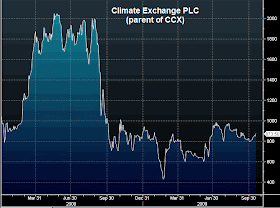Let's take a quick look at options currently available to the Fed and their potential next steps. With the dollar under pressure and bank reserves at
historical highs, one would think the Fed is getting uneasy with all the liquidity in the system. Now that the short-term liquidity facilities are winding down, much of the new securities purchases will increase the balance sheet and
grow the money supply. Many beleive this will surely lead to inflation.
To address this, the Fed has the following two tools (outside of outright securities sales):
1. Purchase new securities (RMBS, Agency paper, etc.) on repo (sterilized purchases). The Fed would effectively buy the securities and immediately lend them out for some period, taking in cash collateral. This takes these securities out of the market, but does not increase the money supply because the proceeds from these sales would not be available to the dealers (the proceeds become the cash collateral). This could be done not only with new purchases, but with securities already on Fed's balance sheet (about $1.5 trillion worth). To accomplish this on a scale that makes a difference, the Fed needs to set up repo lines with banks and dealers outside of the Primary Dealer group. The primary dealers may not have the capital to absorb such massive amounts of repo transactions on their own.
2. The Fed could also raise rates. But this wouldn't be simply raising the Fed Funds Target Rate. Instead the Fed now has the ability to raise interest rate on the reserves that banks keep with the Fed. That immediately creates a floor on rates because banks have no incentive of lending at levels at or below the reserve rate. Instead they can simply deposit the funds with the Fed on a riskless basis. This tool has been used by other central banks for decades.
The first tool may be set up relatively soon, particularly for new purchases, but it's usage should be fairly modest in the near-term. The rate increases however are months away. Here are two reasons for the Fed's dovish approach:
1. The Fed will not take any rate action until they see improvement in employment. And as we
discussed earlier, this may take a while. This is particularly true because many recent jobs (the "bubble jobs") were created on the back of
construction spending.
2. The Fed (among numerous measures available to them) watches one key indicator quite closely: the rate of change in "broad" money supply relative to the "narrow" money supply. It's a measure of how effective the liquidity injections have been in stimulating lending. Banks can be loaded with cash, but if they don't lend, the cash is not making it's way into the broader money supply (the banks effectively stay overcapitalized). And that means the broader economy is not benefiting from the liquidity the Fed had provided, which limits it's growth. The chart below shows the relative growth of M1 (narrow measure) and M2 (broader measure). Until M2 picks up significantly, the Fed will do very little in terms of tightening.

source: St. Louis Fed
Inflation is unlikely to pick up until credit is available in the broader economy to allow corporations and individuals to pay higher prices. With broader money supply responding this slowly, significant price and wage increases are unlikely in the near-term.
The possibility of the Fed actually selling securities from it's balance sheet outright is even less likely. Such sales may impact long-term rates, which may have a negative effect on housing and the consumer, and the Fed will categorically not go there. The RMBS securities, the agency paper, and even treasuries they have bought, will stay on Fed's balance sheet for years to come, possibly to maturity.

























.gif)







